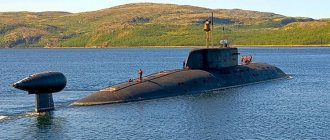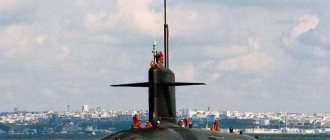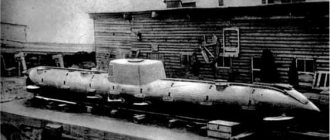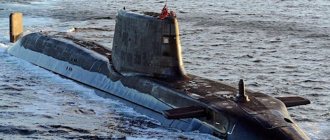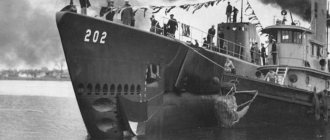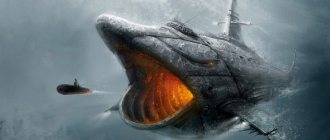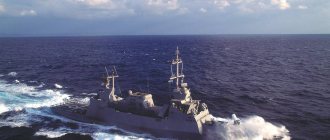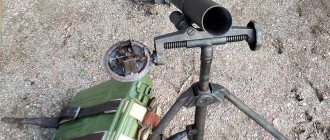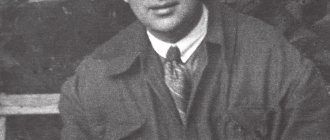Submarines S.K. Drzewiecki
Stepan Karlovich Dzhevetsky, one of the outstanding inventors of submarines of the 19th century, was born into a noble and wealthy noble family in 1843.
He received his education at the Central Engineering School in Paris. In 1877, while sailing on the armed steamship Vesta as a volunteer private, he distinguished himself during a battle with the Turkish battleship Fehti-Bullend, for which he was awarded the St. George Cross for bravery. Taking part in the Russian-Turkish war, he concluded that the most effective weapon against surface combat ships is a submarine. Back in 1876, Dzhevetsky developed a project for a single-seat submarine, which in 1877 he built with his own funds at the Odessa Blanchard plant. The boat, whose length was slightly less than 5 m, was driven by a propeller, the rotation of which was carried out by means of a foot drive, like a bicycle. The submarine contained a tank with compressed air intended for breathing; the spoiled air was removed continuously by a small pump, which was driven by the propeller shaft.
To balance the submarine during underwater travel, a cylinder with a piston and a ballast tank were used. By moving the piston, water was either displaced or received.
The head of the man who was in the submarine was in a glass cover. Two sleeves with rubber gloves served to attach mines to the enemy ship. The mine was detonated using an electric wire after the submarine had retreated to a sufficient distance.
This submarine was tested in 1878 on the Odessa roadstead for 5 months. 10/24/1878 Drzewiecki was able to attach a mine to the anchored dinghy and detonate it. During the tests, Dzhevetsky almost died when trying to pass under the Ereklik yacht, since the depth under the keel was insufficient and the submarine could not pass under it.
The commission that tested the boat, in addition to its positive qualities, noted the short duration of stay underwater, the low speed, and the difficulty of maintaining the required direction. Due to the end of the Russian-Turkish war, Drzewiecki's submarine could not be used in combat conditions.
Dzhevetsky's second submarine was built in 1879 at the Nevsky Shipyard in St. Petersburg.
The submarine was tested by diving to a depth of 7.5 meters. The sheathing was made from 5 mm sheets.
Drzewiecki's first submarine
This submarine was designed for 4 people, and had 2 propellers - one in front and one in back. The propellers were rotary and were used as rudders, the rear propeller moved in a horizontal plane, the front propeller in a vertical plane. The production of the rudder hinges was entrusted to Gube's French workshops, which subsequently gave Gube a reason to make baseless claims to authorship in the design of the submarine itself. Tests of this submarine were carried out in Gatchina on Silver Lake, which was distinguished by its particularly clear water. During these tests, the purpose of which was to show the merits of the submarine to Alexander III, Drzewiecki was able to pass under the royal boat, which was monitoring the evolution of the submarine, and presented a bouquet of magnificent orchids to Empress Maria Feodorovna with the words: “This is Neptune’s tribute to Your Majesty.”
Upon completion of these tests, an order followed for the creation of 50 submarines, which were intended for the defense of coastal fortresses according to the third version of the submarine. The submarines of this version differed little from the previous version. These vessels had one stern propeller that rotated in the plane of the rudder; to maintain the depth during the underwater stroke (trimming), a movable weight was used on the worm shaft. The cargo could move along the length of the ship.
The mines were 50-pound pyroxylin charges placed in rubber bags, inflated with air to impart positive buoyancy, which ensured adherence to an enemy ship.
All 50 submarines were built in 1881. They were distributed as follows: 16 ships were left in Kronstadt; 32 ships were sent to Odessa by rail for distribution between ports on the Black Sea. Of the two remaining ships, one was left to Drzewiecki for further improvements and modernization, one was transferred to the disposal of the Engineering Department and in 1904, according to the design of Lieutenant Yanovich, it was converted into a semi-submarine equipped with a gasoline engine.
The submarine, left at Drzewiecki's disposal, was converted according to the fourth option, which had a new energy source - a battery and an electric motor that rotates the propeller. It is this submarine that has survived to this day and is located in St. Petersburg as an exhibit of the Central Naval Museum. Unfortunately, it is empty inside - no devices or mechanisms have been preserved.
Until 1891, Drzewiecki's submarines were under the jurisdiction of the Engineering Department, and on July 23, 1891, they, along with the large Whitehead mines and Ley mines, were transferred to the Naval Department, which, after examining the submarines, made the following decision:
“Due to the unsuitability of Drzewiecki’s submarines for the active protection of ports in modern conditions of naval warfare and to avoid costs, His Imperial Highness the Grand Duke Admiral General on the 20th day of this July deigned to request permission to break up the said submarines and turn them into scrap metals... ... 3 or 4 boats should be left for port needs, such as: inspection of the underwater part of ships, diving work, hydraulic structures, minefields and various experiments.”
Monument to Dzhevetsky's submarine, installed in Gatchina, the site of testing the second model of the submarine
In accordance with this, submarine No. 35 was left in Libau, two - for diving class, one - at Dzhevetsky.
On the Black Sea in 1893, 2 hulls of Drzewiecki's submarines were used to make a floating buoy, connecting them in parallel, then three of the same buoys were made in Kronstadt.
With the beginning of the Russo-Japanese War, a proposal arose again to use Drzewiecki’s submarines, but by this time not a single serviceable vessel remained. One was corrected, tested on the move and adapted for the use of Schwarzkopf mines, but due to the low tactical and technical characteristics of the boat - quick fatigue of the crew, low speed and yaw while moving - it was never used.
Technical characteristics of Drzewiecki's second submarine: Length - 19.7 feet (about 6 m); Height without hatch - 4.4 feet (1.34 m); Height with hatch - 5.5 feet (1.66 m); Width – 4.3 feet (1.37 m); Submarine weight - 3.3 tons; Propeller speed – 60 rpm; Submarine speed – 2.5 knots; Underwater speed on short runs is 3-3.5 knots; Dive depth - 40 feet (12.5 m).
Water-armored destroyer project
The initial project of the “water-armored” destroyer, which was presented by S.K. Dzhevetsky, was considered by the MTK (Marine Technical Committee) on February 24, 1898. According to the “water-armored” design, the destroyer had 3 decks: a waterproof (main) and two light decks, the gap between which was filled with cork. All the mechanisms of the destroyer were located under the main deck, chimneys, ventilation and “similar” shafts were protected by armor. The hull below the main deck was divided into 10 watertight compartments. Surface/"water-armored" displacement was 300/325 tons, main dimensions: 46.8 m x 5.06 m x 3.4 m/5.4 m, freeboard height was 2/0.45 m, surface speed 25 knots, underwater speed 20 knots, power of Parsons turbines - 4.5 thousand hp, steam production of boilers with oil heating of the Du Temple system is 40 tons per hour. Estimated armament is 4 torpedo tubes and a 47 mm Hotchkiss gun. The armor protection was 25 millimeters thick, the volume of the plug was 60 m3. The volume of ballast water was 25 tons. For drainage, it was planned to use two drainage turbopumps with a capacity of 600 t/hour each.
At the end of 1898 - beginning of 1899, in the experimental pool of the Maritime Department, a model of a “water-armored” destroyer was tested to “determine its resistance in loaded and normal conditions” (vessel draft 4.8 m and 2.8 m, respectively).
S.K. By March 1, 1899, Dzhevetsky presented a detailed design of the vessel. During the consideration of the presented project by the departments of the Technical Committee, several comments were made, for example, the Mine Department (which gave feedback on 05/20/1900) demanded the installation of 8 torpedo tubes and 8 spare torpedoes (on the VP in waterproof boxes weighing 500 kg). By April of the following year, these requirements were reduced to 4 torpedo tubes. The artillery armament, reinforced to two 47 mm and two 37 mm guns, was considered insufficient.
MTK in 1901 decided to build a caisson (“cutting out the middle part of the destroyer, but without respecting the shape of the bottom”) to evaluate the survivability of the proposed design. The caisson, measuring 7.5x5.2x3.6 meters, was built under the supervision of naval engineer E.E. Gulyaev. at the Admiralty plant.
Experiments carried out in July-August 1902 revealed the high survivability of the structure when 75- and 152-mm shells exploded in the interdeck space. In the event of a forced detonation of a 120 mm caliber projectile, a triangular hole measuring 60x50x40 millimeters was formed inside the caisson, the decks and bulkheads received significant damage, and the compartment sank. The compartment was subjected to two more series of tests in 1903. Their main goals were to determine the conditions for the penetration of projectiles, to determine the impact on the integrity of the air cushion body during explosions, as well as the degree of destruction during the explosion of 152-mm projectiles in “water armor”. The shells, according to the commission's conclusion, penetrated the water to a depth of less than 30 cm, the main deck and the side of the caisson remained undamaged.
Taking into account the results of these tests and testing of Rato turbines in France, the MTK on December 7, 1904 recognized the construction of a destroyer as desirable, and the St. Petersburg Metal Plant was proposed as the construction plant. At the same time, Dzhevetsky S.K. it was proposed to increase the vessel's displacement to 560 tons, with an increase in the number of torpedo tubes to 8, and artillery to 6 57 mm caliber guns. The surface speed was supposed to be 26 knots. In April of the following year, permission was issued for the construction of a “water-armored destroyer” and a submarine with a single engine “Pochtovy” based on Dzhevetsky’s designs. Non-budgetary funds were only sufficient for the construction of a submarine.
Schematic diagram of the experimental compartment of the “water-armored” destroyer S.K. Dzhevetsky: 1 - shaft with ladder; 2 — cork float; 3 - main deck
Longitudinal section and section of the “water-armored” destroyer S.K. Dzhevetsky 1893: 1 - ballast tanks; 2 - volume filled with cork mass; 3 — sealed hatches; 4 - armored cabin; 5 - ventilation pipe; 6 - chimney; 7- torpedo in the apparatus; 8 - steam boiler; 9 - steam engine; 10 - living quarters (in submerged position); 11 - main deck
"Water-armored" destroyer S.M. Drzewiecki (variant)
Scheme of the “water-armored” destroyer S.K. Dzhevetsky (version 1905): 1 - cannon; 2 — spotlight; 3 - side niches for folding mine (torpedo) tubes
The final version of the preliminary design of the destroyer was presented at Marine Tech. Committee July 13, 1906. Despite the fact that the Metal Plant offered to take over the construction of the destroyer, it was decided to conduct new experiments that take into account a 4-fold increase in the charge of the shells. The new caisson was launched on October 25, 1908, and in 1910 the Naval General Staff decided that “there is no need for the Dzhevetsky water-armored destroyer.”
Designer – Dzhevetsky S.K.; Construction plant – Metal plant (St. Petersburg); Project development time: 1892-1906; Main performance characteristics: Displacement – 550 tons; Length – 76 m; Maximum width – 7.8 m; Draught on the surface – 4 m; Draft during “water armored” immersion – 5.8 m; Crew – 20 people; Type of power plant – boiler-steam turbine; Engine type – steam turbine of the Rato system; Number of steam turbines – 3; Total power – 6000 hp; Number of steam boilers – 8; Type of oil boilers – “Solignac and Grill”; Type of installation for underwater travel – electric; Number of propeller shafts – 4; Number of AB groups – 2; Maximum surface speed – 24-25 knots; The maximum speed in the “water armored” position is 20-21 knots; Maximum speed in submerged position – 15 knots; Diving range – 500 miles; Surface navigation range - 2000 miles; Armoring of air pipes and chimneys – 50 mm; Fuel oil reserve – 60 tons; Torpedo armament: - number of torpedo tubes - 2; - caliber of torpedo tubes - 381 mm; - total number of torpedoes - 6; Artillery weapons: - number of artillery installations - 6; - caliber of artillery installations - 57 mm.
Changes in tactical and technical characteristics during the design of a water-armored destroyer Year of presentation of the project - 1893/1897-1899 /1905/1905/1907; Length between perpendiculars – 43.4 m/46.8 m/ – /63.7 m/72 m; Maximum width – 4.0 m/5.06 m/ – /6.53 m/6.73 m; Recess with keel – 3.35 m/3.40 m/4.0 m/4.1 m/3.8 m; Displacement – 140 t/300 t/550 t/560 t/610 t; Weight of water ballast – 15 t / 25 t / about 60 t / - / about 72 t; Displacement in water-armored position - 155 t / 325 t / about 615 t / - / about 690 t; Recess in the water-armor position – 5.1 m/5.38 m/5.8 m/5.73 m/5.60 m; Type of main power plant - steam engines, 3 shafts/turbines/turbines, 2 shafts/turbines, 2 shafts/turbines, 2 shafts; Total power of the power plant - 2400 hp/4500 hp/6000 hp/ - /7000 hp; Surface speed - 24 knots/25 knots/25 knots/26 knots/25 knots; "Water" speed - 19.5 knots/20 knots/20-21 knots/21 knots/20 knots; Fuel reserve - for 70 hours at 14 knots/60 t/60 t/44 t/140 t; Economy cruising range travel - 980 miles (at a speed of 14 knots) / 1200 miles (at a speed of 10 knots) / 2000 miles (at a speed of 14 knots) / 3000 miles (at a speed of 15 knots); Armament: - number of mine vehicles - 2/4/8/8/8; - stock of mines - 6/ - / - / - / - - number of artillery installations and their caliber - 1x47 mm/art. and bullet/5-6×57 mm/4×75 mm, 6 bullets; Crew – 12 people/ — / — / — / —
Making sense of experience
Four of the 13 submarines of the “separate detachment” reached Vladivostok after the end of the war.
Due to late delivery, the Sturgeon-class submarines did not have time to take part in hostilities. A common drawback of all submarines of those years was the unreliable operation of internal combustion engines. The roughness of the sea, a strong swell, rocked the boats on the surface so that the electrolyte splashed out. Internal explosions occurred several times during the war. The death of the sailor was caused by an incident on the Dolphin, which was caused by the ignition of gasoline vapors.
Poor living conditions created constant discomfort, reducing the efficiency of the crew. Since the boats were structurally non-compartmental, and the ventilation system was ineffective, a mixture of gasoline vapors, oil fumes and exhaust was constantly kept inside the ship. Add to this the increased humidity and the lack of opportunity for the crew to dry their clothes after the shift. There was no special clothing for working inside the boat. Only the Soma team was lucky: they were equipped with waterproof clothing made of squirrel fur.
The boats built according to the designs of the American engineers Holland and Lack and the boats developed by Bubnov turned out to be comparable in general technical level, seaworthiness and combat qualities.
Domestic submarines differed from “foreign” submarines in their high speed and cruising range. They also had stronger weapons. True, Dzhevetsky’s torpedo tubes did not work in the cold, which limited the combat value of the killer whales in the winter. In addition, the torpedoes in Drzewiecki’s apparatus were in the water throughout the voyage, and in order to remain ready for firing, they had to be lubricated frequently.
